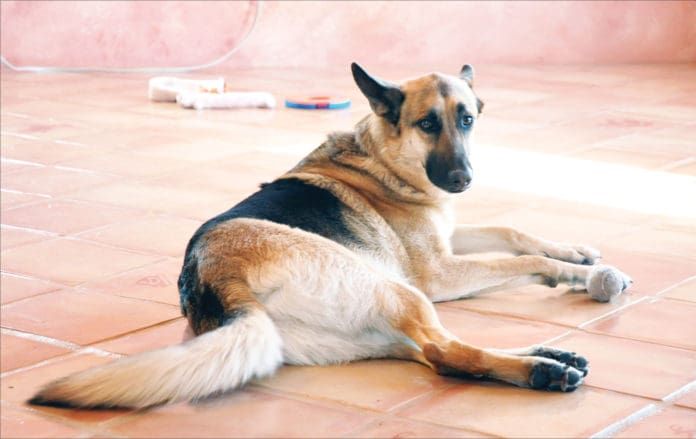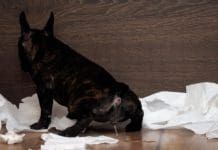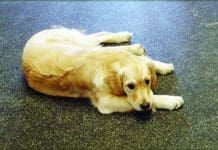[Updated July 6, 2018]
It’s very disconcerting when your well-housetrained dog suddenly starts having accidents in the house. It may be human nature to think he’s doing it to spite you, but that’s not the case – a well-trained dog doesn’t just start soiling indoors on a whim. There’s a legitimate reason it’s happening, and you owe it to your dog to find out why.

Here’s what you need to do:
1. Explore possible medical causes of your dog’s accidents.
Something as simple as a urinary-tract infection or as complex as diabetes (causes increased thirst and water consumption, which causes increased urination) can be the cause of your dog’s indoor puddles. There are many common medical causes of increased urination. Gastrointestinal distress, which causes anything from slightly loose stools to liquid diarrhea, can prompt your dog to defecate indoors as well. Any dog can have an accident, but if yours has uncharacteristically started house soiling regularly, get thee to thy veterinarian as soon as possible for a complete workup.
2. Check if medications are causing your dog to soil the house.
A number of canine medications used to treat common health conditions can also cause increased water consumption followed by increased urination. Prednisone, used to treat a variety of ailments, is a prime example. Other medicines can cause gastrointestinal distress, which can also result in house soiling. If your dog is on any medications, ask your veterinarian whether that could be the cause of his break in training.
3. Look for possible stressors for your dog.
Urination and defecation can be a dog’s response to stress. Check your environment to see if there’s something going on that might provoke this stress response in your dog. Construction next door with loud machinery? Neighborhood kids who have discovered it’s fun to bang on your door to tease the dog? A watch alarm beeping in a drawer? Set up your laptop camera or nanny cam and see if you can make a correlation between stimuli, stress, and soiling. If you can’t find a specific trigger, then evaluate your dog’s total stress load and see if removing as many stressors as possible can help him return to his prior fastidious habits.
4. Evaluate your routine.
Are you working overtime a lot? Stopping on the way home at a local pub for some face time with your new honey? Perhaps your dog was just barely holding it with legs tightly crossed before, and the extra time it’s taking you to get home now is just more than he can handle.
If so, and if you can’t return to your prior schedule, then make arrangements with a neighbor or family member to let your dog out at midday or late afternoon, or hire a good petsitting service to do it.
5. Revisit basic housetraining lessons.
It’s worth putting serious energy into discerning the cause of your dog’s house soiling. If you discover and remove the cause of his problem, your dog may immediately return to his former pristine ways.
Or he may not. If that’s the case, or if you simply can’t find a reason, it’s time to go back to basic housetraining. You probably won’t have to implement the puppy “every hour on the hour” routine, but you do need to make sure he gets outside more often than he has to go. If you work all day, this might mean putting him back in a crate or exercise pen until he is successfully retrained, and hiring a professional petsitter (or arranging with a friend or neighbor) to let him out for a potty break at least once, preferably two or even three times during the day.
Just keep in mind that there’s a reason your housetrained dog might eliminate indoors – and neither spite, anger, jealousy, nor any other human emotion we might blame has anything to do with it. It’s up to you to find the reason and help him return to spotless living.






